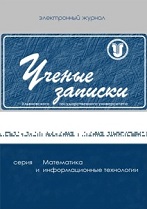|
|
Uchenyye zapiski UlGU. Seriya "Matematika i informatsionnyye tekhnologii", 2020, Issue 1, Pages 58–71
(Mi ulsu27)
|
 |
|
 |
Technology of the intelligent system design (synthesis) to robot control based on the mathematical model of cognitive digital automation
V. V. Kozhevnikova, M. Yu. Leontievba, V. V. Prokhod'koa, V. A. Sergeevb, A. N. Fomina
a Ulyanovsk State University, Ulyanovsk, Russia
b Ul'yanovsk Branch of Institute of Radioengineering and Electronics, Russian Academy of Sciences
Abstract:
An intelligent control system (ICS) to control robots can be implemented (designed) on the basis of the mathematical model of a cognitive digital automaton (CDA). The ICS in this case is a software and hardware complex, where the mathematical model of the CDA defines the control system as an intelligent one. The cognitiveness of the mathematical model is determined by the possibility of generating new knowledge based on the knowledge gained at the learning stage.
The feature of the mathematical model of CDA is that the description of the neural network (NN) structure serves as the initial structural diagram of the automata, and the logical function "NOT-AND-OR" is used as the model of the neuron. As a tool for constructing the mathematical model of CDA proposed the mathematical apparatus of Petri nets (PN).
The paper considers the structure, composition, and synthesis algorithm of an intelligent robot control system based on the mathematical model of CDA. In accordance with the algorithm, the ICS is formed in three modes: preliminary training, manual and automatic control. That is, teaching the mathematical model of the CCA can be performed both in manual mode and in automatic control mode. The possibility of learning in automatic control mode, in turn, provides the ability to regenerate knowledge and, accordingly, the possibility of cognitive control.
Keywords:
intelligent control system, robots, cognitive automata, neural networks, learning, cognition, thinking, Petri nets, equation of states, mathematical modeling, synthesis, generation, analysis, logic.
Received: 22.05.2020
Revised: 10.06.2020
Accepted: 11.06.2020
Citation:
V. V. Kozhevnikov, M. Yu. Leontiev, V. V. Prokhod'ko, V. A. Sergeev, A. N. Fomin, “Technology of the intelligent system design (synthesis) to robot control based on the mathematical model of cognitive digital automation”, Uchenyye zapiski UlGU. Seriya “Matematika i informatsionnyye tekhnologii”, 2020, no. 1, 58–71
Linking options:
https://www.mathnet.ru/eng/ulsu27 https://www.mathnet.ru/eng/ulsu/y2020/i1/p58
|

| Statistics & downloads: |
| Abstract page: | 56 | | Full-text PDF : | 21 | | References: | 13 |
|




 Contact us:
Contact us: Terms of Use
Terms of Use
 Registration to the website
Registration to the website Logotypes
Logotypes








 Citation in format
Citation in format 